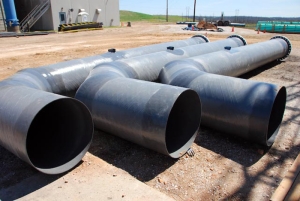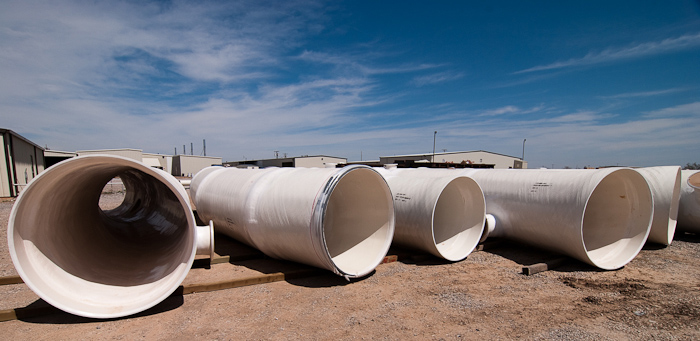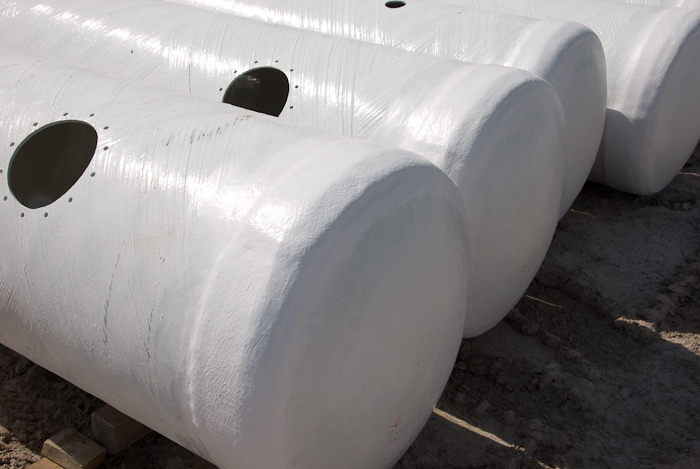Using CNC Manufacturing to Create Custom FRP Products
 CNC stands for Computer Numeric Control. CNC Machining is a process used in the manufacturing sector that involves the use of computers to control machine tools. Tools that can be controlled in this manner include lathes, mills, routers and grinders.
CNC stands for Computer Numeric Control. CNC Machining is a process used in the manufacturing sector that involves the use of computers to control machine tools. Tools that can be controlled in this manner include lathes, mills, routers and grinders.
 The CNC process is relatively straightforward. First, a CAD drawing is created (either 2D or 3D), second, a code is created that the CNC machine will understand. The program is loaded and finally an operator runs a test of the program to ensure there are no problems. This trial run is referred to as “cutting air” and it is an important step because any mistake with speed and tool position could result in a scraped part or a damaged machine.
The CNC process is relatively straightforward. First, a CAD drawing is created (either 2D or 3D), second, a code is created that the CNC machine will understand. The program is loaded and finally an operator runs a test of the program to ensure there are no problems. This trial run is referred to as “cutting air” and it is an important step because any mistake with speed and tool position could result in a scraped part or a damaged machine.
 The upfront cost of CNC machines can be steep, but the long-term advantages of employing CNC technology for the manufacturing of precision FRP products, far outweighs the initial cost.
The upfront cost of CNC machines can be steep, but the long-term advantages of employing CNC technology for the manufacturing of precision FRP products, far outweighs the initial cost.
Many end users of FRP products look for someone who can guide them to the most efficient production approach, one that saves time, money, and resources—CNC manufacturing is one piece to that puzzle. Here are some of the advantages of using CNC manufacturing to create custom FRP products.
- Precision—Once the design is programmed into the CNC machine it can be repeated hundreds or even thousands of times with a high degree of accuracy. A CNC machine will produce replications that are an exact match and there will be no variation from component to component—thus eliminating human error and fatigue.
- Adaptability—Not only are CNC machines capable of handling a wide range of designs and materials from wood, metal, plastic, pultruded composites, and FRP—just to name a few. In addition, CNC machines are capable of creating complex 3D shapes that would be extremely difficult if not impossible to achieve by a skilled machinist.
- Programmability—CNC machines can be programmed by advanced design software, enabling the manufacture of products that cannot be made by manual machines, even those used by skilled designers / engineers.
 Saves Time and Money—Modern design software allows the designer to simulate the manufacture of his/her idea. There is no need to make a prototype or a model. This saves time and money. One person can supervise many CNC machines as once they are programmed they can usually be left to work by themselves.
Saves Time and Money—Modern design software allows the designer to simulate the manufacture of his/her idea. There is no need to make a prototype or a model. This saves time and money. One person can supervise many CNC machines as once they are programmed they can usually be left to work by themselves.- Low Maintenance—CNC machines can be used continuously 24 hours a day, 365 days a year and only need to be switched off for occasional maintenance. Their reliability, precision, ease of operation and adaptability ensure that the end user gets a cost-effective approach to their design.
At Beetle, our comprehensive capabilities include CNC manufacturing, open molding (hand lay-up and spray-up), precision molding and tooling, filament winding, vacuum infusion, equipment rebuilding, on-site modifications and custom manufacturing/fabrication. We have over 50 years experience in fiberglass—in that time we’ve developed unmatched dedicated design and field services that enable us to guide you to the most efficient production approach.

 There are many
There are many 
 Fiber Reinforced Polymers (FRP) are unique composite materials in many respects. For starters, they can be formulated to be corrosion, abrasion, and UV resistant, as well as, smoke and fire retardant. FRP are often a cost-effective choice in many industrial applications; they have long life cycles and have demonstrated durability in stringent environments with reduced maintenance costs. Here are five reasons FRP stand out when compared to metals and metal alloys.
Fiber Reinforced Polymers (FRP) are unique composite materials in many respects. For starters, they can be formulated to be corrosion, abrasion, and UV resistant, as well as, smoke and fire retardant. FRP are often a cost-effective choice in many industrial applications; they have long life cycles and have demonstrated durability in stringent environments with reduced maintenance costs. Here are five reasons FRP stand out when compared to metals and metal alloys. There are many important predictors of service life in industrial chemical processes; for example, humidity, temperature, pressure, and stress. Similarly, chemical resistance is a key predictor of
There are many important predictors of service life in industrial chemical processes; for example, humidity, temperature, pressure, and stress. Similarly, chemical resistance is a key predictor of  In our
In our  If you’ve been paying attention to fiberglass trends you’d know that corrosion, a serious problem that pits and corrodes most metals and metal alloys, has created huge market opportunities for Fiber Reinforced Polymers (FRP) including pipe, duct, and tanks. Despite the many opportunities FRP manufactures have seized over the years, some major obstacles still persist, chief among them is education—or getting the word out.
If you’ve been paying attention to fiberglass trends you’d know that corrosion, a serious problem that pits and corrodes most metals and metal alloys, has created huge market opportunities for Fiber Reinforced Polymers (FRP) including pipe, duct, and tanks. Despite the many opportunities FRP manufactures have seized over the years, some major obstacles still persist, chief among them is education—or getting the word out.  Ferric chloride or FeCl3, is an industrial scale commodity chemical compound that has many important industrial applications. When dissolved in water, FeCl3 undergoes hydrolysis and gives off heat in an exothermic reaction. The resulting brown, acidic, and corrosive solution is used as a flocculant in sewage treatment and drinking water production, and as an etchant for copper-based metals in printed circuit boards.
Ferric chloride or FeCl3, is an industrial scale commodity chemical compound that has many important industrial applications. When dissolved in water, FeCl3 undergoes hydrolysis and gives off heat in an exothermic reaction. The resulting brown, acidic, and corrosive solution is used as a flocculant in sewage treatment and drinking water production, and as an etchant for copper-based metals in printed circuit boards.



